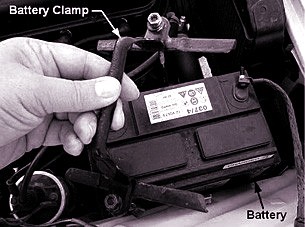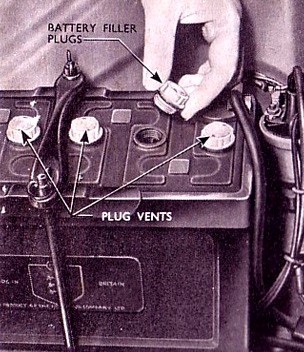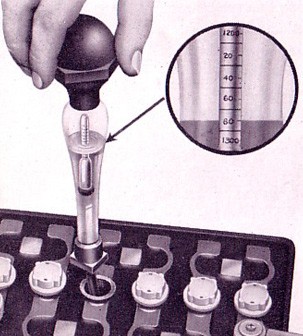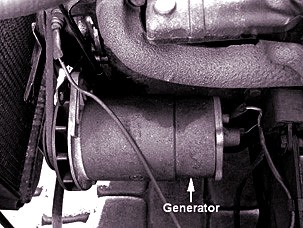You are in:

Electrical
System |

General
Maintenance - Electrical System
| The electrical
system of the car consists of the 12-volt
generator, starter motor and ignition circuits,
which includes circuits for the fuel gauge,
horns, lights, indicators, and heater blower
motor (when fitted) and other accessories.The
complete car wiring circuit can be found here,
and shows the locations of the various electrical
units as can be visualised from a plan view of
the car. The Battery
The battery is a 12-volt lead acid type with nine
plates in each cell and a 38 ampere hour (51 AH
Special Equipment) capacity. The battery is
easily accessible by raising the engine bonnet.
The generator charging system is
automatically controlled to suit the needs of the
battery and, as a result, the battery should
seldom require any attention other than topping
up with distilled water. If however it does
become run down for any reason, it should be
recharged as a soon as possible;: it will
deteriorate if it is allowed to stand for any
length of time in a discharged condition.
The
positive terminal can be easily identified by an
embossed + (positive) mark adjacent to it. The
positive terminal base may also be red in colour.
When replacing the battery, always ensure that
the positive terminal is earthed to the body by
means of the short earth strap. (Warning –
If the vehicle has been changed to “Negative
Earth”, then please ensure that the earth
strap is attached to the – (negative)
terminal of the battery.)
It is most
important to ensure that the battery is firmly
secured and not allowed to shake loose in its
mountings. High resistances in the battery
circuit can also be caused by loose, dirty or
corroded battery terminals. Always keep the
connections clean and tight and the top of the
battery
|
To Replace the Battery
To replace a failed or faulty battery, first
remove the leads from the battery terminals.
Unscrew the wing nuts on the battery clamp and
unclip the battery arms from the battery tray.
The battery can now be lifted out.Refit
the new battery, ensuring that the negative and
positive terminal posts are the correct way
around. Refit the battery clamp and battery
leads.
Warning
– Do not tip the battery over allowing the
electrolyte to discharge as this may cause
injury. Do not dispose of the old battery in your
refuse. Take it to your local Council Recycling
Centre.
|
 |
Check the Battery
Electrolyte Level - (Weekly Service)
The battery is
accessibly located under the bonnet, within the
engine compartment. Remove the filler caps and
check that the electrolyte in each cell is 1/4 to
3/8 in (6.35 to 9.525 mm) above the tops of the
plates. If below this level add distilled water
as necessary. (In cold weather the distilled
water should only be added immediately before
running the engine, so that when the generator is
charging, the water and electrolye will mix and
prevent freezing.) The filler caps can now be
refitted.Keep the battery filler
caps and battery connections tight and the top of
the battery clean. A coating of petroleum jelly
will protect the battery terminals. Occasionally
check the battery clamp to ensure that the
mounting wings nuts are tight and the battery is
still secure in the battery tray. Excessive use
of distilled water by the battery is usually an
indication of an unduly high generator-charging
rate and you should consult an Auto Electrician
and have the charging system checked.
|
 |
Battery Specific Gravity
The specific gravity is an indication of the
state of charge of the battery and should be
checked regularly with a hydrometer. The specific
gravity of the electrolyte of a fully charged
battery should be between 1.270 and 1.285 at 70º
F
When the acid temperature varies from 70º F a
correction must be made as follows:-
For every 10º F above 70º F, add 0.004 to the
specific gravity reading.
For every 10º F below 70º F, subtract 0.004
from the specific gravity reading.If
the level of electrolyte is so low that a
hydrometer reading cannot be taken, no attempt
should be made to take a reading until the
battery has been charging for at least an hour
after adding distilled water. This is to ensure
that the acid mixes thoroughly with the water to
form a uniform mixture. If the specific gravity
of the electrolyte is found to be low, the
battery should be recharged, preferably by your
Authorised Ford Dealer.
|
 |
Generator (Dynamo)
A two-brush generator is mounted on the left hand
side of the engine and its output is
automatically controlled by a separate voltage
control regulator. If it is suspected that the
generator charge rate is not being regulated
correctly in accordance with the needs of the
battery, your Authorised Ford Dealer should be
allowed the check the regulator voltage and
adjust it if necessary. Periodically, it is
recommended that you have the generator voltage
checked with the aid of a master voltmeter. |
 |
Cleaning
the Generator Commutator and Brushes
Occasionally, it may be necessary to clean the
commutator and brush gear. To do this, the
generator must be removed from the car and the
endplate withdrawn so that a thorough inspection
of the commutator can be made. If this latter
component requires attention, then the generator
will have to be further dismantled. If it is just
a matter of a greasy or dirty commutator, this
may be leaned with a petrol-moistened non-fluffy
cloth held lightly against the commutator whilst
the armature is being rotated.
If the commutator is found to be scored, take it
to your Authorised Ford Dealer, who has the
necessary equipment to restore the surfaces to a
good working condition without damaging the
segments. Never use emery cloth to clean the
commutator.Ensure that the bushes are
free to move in their holders. If the brushes are
found to be tight or sticking then they should be
drawn from their holders and the sides of the
brushes eased with a fine file.
If the brushes are exceptionally worn and reduced
in length, they should be renewed, as there would
otherwise be insufficient spring tension to keep
them pressed against the commutator.
Voltage
Control Regulator

Starter
Motor
The starter motor is mounted on the right hand
side of the engine and is operated by a solenoid
switch mounted on the right hand side of the
engine bulkhead. Should it be necessary to rotate
the engine while working under the bonnet, this
may be achieved by pressing the rubber cap on the
starter switch after checking that the ignition
is “off” and the gear lever is in
neutral.
It requires no
attention beyond seeing that the cable
connections are clean and tight, the commutator
is kept clean and the brushes are renewed when
necessary. Should the need arise, the starter
pinion can be manually disengaged by removing the
starter motor end cap and turning the squared end
of the shaft.
|
Information taken from Various Ford
Anglia Instruction Books and Handbooks..

Warning -
The Health and Safety bit.
Please note your health may be at
risk if you do not take sensible safety
precautions. Never work under an unsupported
vehicle, do not take shortcuts. If you feel that
the task is beyond your capabilities, then employ
the services of a trained professional. The Owner
of this Website nor the author cannot be held
responsible for any accidents or injury arising
from advice given on this webpage. Safety advice
can be obtained from the RoSPA.
|




|
|

